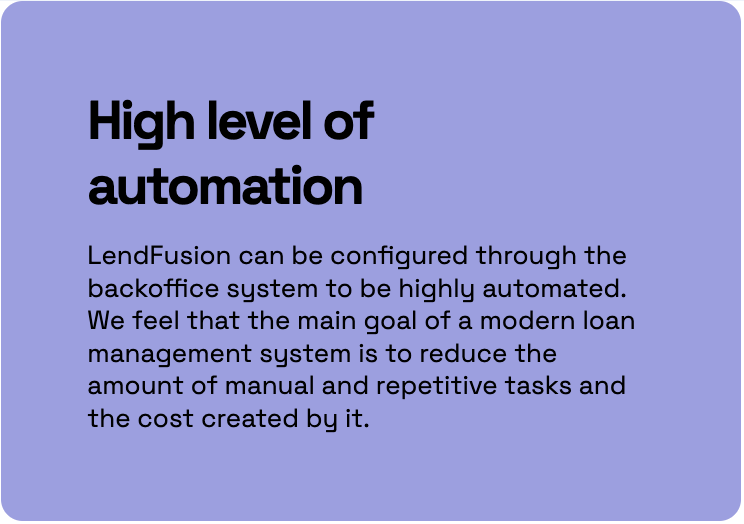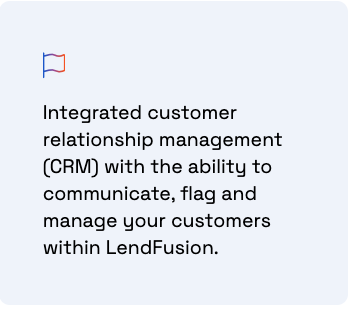4 Challenges in Loan Management (and How Software Addresses Them)

Do you find yourself dealing with lengthy loan applications, prone-to-error verifications, and the challenges of handling a high volume of loan requests?
You’re not alone.
In fact, these challenges are common struggles among global lenders.
But imagine if there was a way to make these processes smoother, accelerate business growth, and improve customer relationships.
The solution?
In this article, we’ll highlight 4 major challenges you’re currently facing and show you how loan management software solves them, leading to a more streamlined and efficient lending process.
4 Key Challenges in Loan Management
The search for efficient loan management comes with its fair share of obstacles.
These typically include:
- Lengthy applications
- Manual verifications
- Poor customer experience
- Handling of multiple applications
These challenges often pose as stumbling blocks, preventing growth and leading to operational inefficiencies, providing a need for a more robust loan management system
Let’s explore each of the four loan management challenges in more detail below.
1. Lengthy Loan Applications
Lengthy loan applications are a challenge for both borrowers and lenders.
- For borrowers, extended loan applications can lead to increased interest charges throughout the loan duration, impacting their financial decision-making and overall financial well-being.
- For lenders, lengthy applications take up more resources, leading to decreased credit quality and heightened credit risk.
Common causes for long loan application processing times in the lending sector include:
- A low credit score
- A high debt-to-income ratio
- Insufficient or unstable income
- Recent credit history or bankruptcy
- Inconsistent employment history
The good news is that technology significantly reduces manual verification requirements, supports data-driven decision making, and optimizes the approval and disbursement process, including manual payment processing.
2. Manual Verifications
Manual verifications limit the loan management process.
They contribute to a slow and inefficient process with a high potential for errors, causing delays for clients and relying largely on the verification team’s expertise and training consistency.
All of this negatively impacts both borrower and lender experiences.
The delays from manual verifications are due to the tedious processing of paperwork and issues with incomplete or missing documents, slowing down the loan approval process until the issues are resolved.

Error rates are high, too.
In fact, the error rates associated with manual verification can be substantial, ranging from 6.5% to 10%, highlighting the potential for inaccuracies in the loan approval process.
3. Poor Customer Experience
In the world where customer is king, a complex loan application process can lead to a negative customer experience, decreased business, and a tarnished reputation.
The typical factors contributing to a poor customer experience during the loan application process include:
- User interface (UI) and user experience (UX) design
- Cumbersome processes and outdated technologies
- Inefficiency
- Lack of clarity
- Poor communication
- Substandard services and customer service
In addition, a complex loan application process can:
- Overwhelm the relationship-based aspects
- Weaken the lender’s reputation
- Cause confusion, delays, errors, and frustration for the business
- Pose a significant challenge
4. Multiple Application Management
Managing multiple loan applications can be a headache for established lenders.
Especially if you manage them manually.
These challenges typically include:
- Confusion over terms and offers
- Delays in paperwork
- Form errors
- ID verification wait times
- Collecting signatures
- Repeated data entry
- Document gathering
- Providing inaccurate loan application information
Mistakes caused by handling multiple loan applications can lead to an unsatisfactory customer experience, causing business setbacks and, perhaps worst of all, damaging a lender’s credibility.
Loan management software greatly improves the handling of multiple submissions and reduces the chance of errors. It achieves this by streamlining the management of numerous applications and refining loan management processes for better efficiency.
4 Ways Loan Management Software Solves them
Loan management software solves these challenges by:
- Automating tasks
- Simplifying processes
- Improving accuracy
- Creating a better customer experience
By overseeing the origination and servicing procedures of loans, loan management software is a necessity for lenders to manage loans, address the difficulties encountered in the loan process, streamline workflows, and maintain competitiveness.
1. Automated Loan Processing
Automated loan processing shows how technology has transformed the lending sector.
At its core, it refers to the utilization of technology and tools to automate the loan origination process, encompassing activities such as data mining, credit decision-making, and enhancing operational efficiency.
For instance, platforms like LendFusion offer an automated loan processing feature, helping lenders benefit from:
- Handle loan applications directly within the system (eliminating the need for an IT team)
- Speed up the process
- Reduce errors
- Improve customer satisfaction

2. Enhanced Verification
Verification is a critical step in the loan management process, and enhancing this process can significantly reduce errors and improve overall loan management.
Improved verification facilitates a proactive loan monitoring process, considering a wider spectrum of data and streamlining the loan offering, verification, and disbursing process, particularly in large organizations.
LendFusion, for example, incorporates enhanced verification into its loan management software by seamlessly integrating and analyzing third-party systems for:
- Identity verification/authentication
- Fraud check
- OFAC
- Blacklist checks
This ensures KYB (Know Your Business) and AML (Anti-Money Laundering) compliance.
LendFusion integrates directly with existing software, including Pay360, Stripe, GoCardless, AWS, Experian and more.
3. Improved Customer Experience
Given the customer-centric business model of today, enhancing customer experience is paramount. Loan management software plays a pivotal role in this arena by implementing a user-centered design approach, ensuring that the solution is user-friendly and intuitive.
Furthermore, an enhanced customer experience contributes to customer loyalty by:
- Enhancing transparency
- Alleviating customer anxiety
- Fostering trust
- Ultimately yielding positive financial outcomes that are advantageous for both the company and its clientele.

4. Scalable Support
Another significant feature of loan management software is its scalable support.

This helps you manage a growing number of loans without the need for additional manual intervention.
This functionality enhances efficiency and facilitates business expansion.
In addition:
Scalable support in loan volume management offers advantages such as agility, flexibility, and the capacity to manage high loan volumes. It enables businesses to attract a larger client base, expand their operations, and ultimately, grow their business.
3 Essential Features of a Loan Management System
A robust loan management system that effectively tackles these challenges in loan management should include features like loan origination, borrower relationship management, and loan terms management.
1. Loan Origination
Loan origination is a fundamental part of the loan management process.
It automates the collection of essential information, including income verification and credit checks, thus streamlining the loan application process.
Key stages involved in the loan origination process encompass pre-qualification, loan application, application processing, underwriting, credit decision, and quality check.
The role of technology in this process cannot be understated, as it optimizes income verification during loan origination and evaluates borrower’s financial well-being, offering lenders an essential overview for risk evaluation.
2. Borrower Relationship Management
Another pillar of a loan management system is borrower relationship management. It involves the centralization of loan documents and communication with the aim of enhancing efficiency and customer satisfaction.

The role of technology in borrower relationship management is pivotal. It facilitates the use of contemporary CRM systems to:
- Categorize clients
- Equip loan officers with efficient tools for client management
- Facilitate document verification
- Enhance communication
- Provide market intelligence
(Note: All LendFusion customers get access to our CRM platform. Read more about the product here).
3. Loan Terms Management
An essential feature of a loan management system is loan terms management.
It allows for easy tracking and updating of relevant information, such as interest rates and payment schedules.
Platforms like LendFusion contribute to the management of loan terms by offering features such as automated actions, loan product configuration, and a customer area, all of which work to streamline the process and enhance efficiency.
Precise management of loan terms:
- Enhances operational efficiency
- Ensures that borrowers receive precise and timely loan information
- Enables borrowers to plan their finances accurately
- Improves borrowers’ overall experience.
Conclusion
Technology and innovation in loan management has revolutionized the industry.
And what used to be a challenge is now solved through automation and more efficient processes – making them a lot more manageable.
The future of lending is exciting – and by focusing on customer experience, you’re tapping into new growth opportunities for your business.
Technology is reshaping loan management, ushering in a new era where efficiency, customer satisfaction, and business expansion become standard in the lending world.
It’s time to become part of the new era.
See how LendFusion solves these loan management challenges first-hand. Book a demo today and one of our experts will discuss your business goals and how LendFusion can help you reach them.
Lenders also ask
How can businesses implement these solutions cost-effectively, especially small to mid-sized enterprises with limited budgets?
Small to mid-sized enterprises (SMEs) can implement cost-effective solutions by focusing on scalable, cloud-based loan management systems that offer affordable pricing.
Choosing the right platform that prioritizes features essential to their operations can also reduce costs.
In addition, leveraging automation for routine tasks can streamline operations, allowing for more efficient use of resources and potentially lowering the need for extensive manual labor.
What additional tools or integrations are recommended to enhance the effectiveness of the solutions mentioned for managing loan challenges?
To improve the effectiveness of solutions for managing loans, businesses often integrate additional tools like CRM systems for better customer relationship management, analytics platforms for deeper insights into loan performance, and compliance software to ensure regulatory adherence.
These integrations can offer a more holistic approach to loan management, enabling businesses to streamline lending operations, improve customer engagement, and mitigate risk more effectively.
What future trends in loan management should businesses be aware of to stay ahead of these challenges?
Businesses should keep an eye on trends like AI and machine learning for improved risk assessment and personalized lending, blockchain for secure and transparent transactions, and regulatory technology (RegTech) for compliance management.
Another key trend:, the rise of peer-to-peer lending platforms indicates a shift towards more democratized finance, requiring traditional lenders to adapt their strategies.

Andres Valdmann, CEO
Andres is the Chief Executive Officer at LendFusion. Andres has 15 years of experience in fintech and loan management software and has a proven track record in helping companies hit their growth goals.
Connect with Andres on LinkedIn.



